Comprehensive Report: Play and Learning in Early Childhood Education
VerifiedAdded on 2021/04/21
|13
|3590
|320
Report
AI Summary
This report offers a comprehensive analysis of play and learning within the context of early childhood education. It begins by examining the current understanding of play and playful pedagogy, highlighting how play creates opportunities for children to learn, discover, and create, fostering social group dynamics and new understandings. The report then delves into the play continuum, detailing the various roles adults can assume to support children's play, from spectator to co-player, and emphasizes the importance of considering the learning environment. Furthermore, it underscores the significance of understanding children's perspectives, advocating for observation, listening, and the use of diverse methods to capture their views. The report concludes by emphasizing the importance of co-constructing knowledge with children and fostering a thinking environment that values trust and innovation, all to promote the development of children.

Running head: PLAY AND LEARNING IN EARLY CHILDHOOD
Play and Learning in Early Childhood
Name of the student
Name of the University
Author note
Play and Learning in Early Childhood
Name of the student
Name of the University
Author note
Paraphrase This Document
Need a fresh take? Get an instant paraphrase of this document with our AI Paraphraser
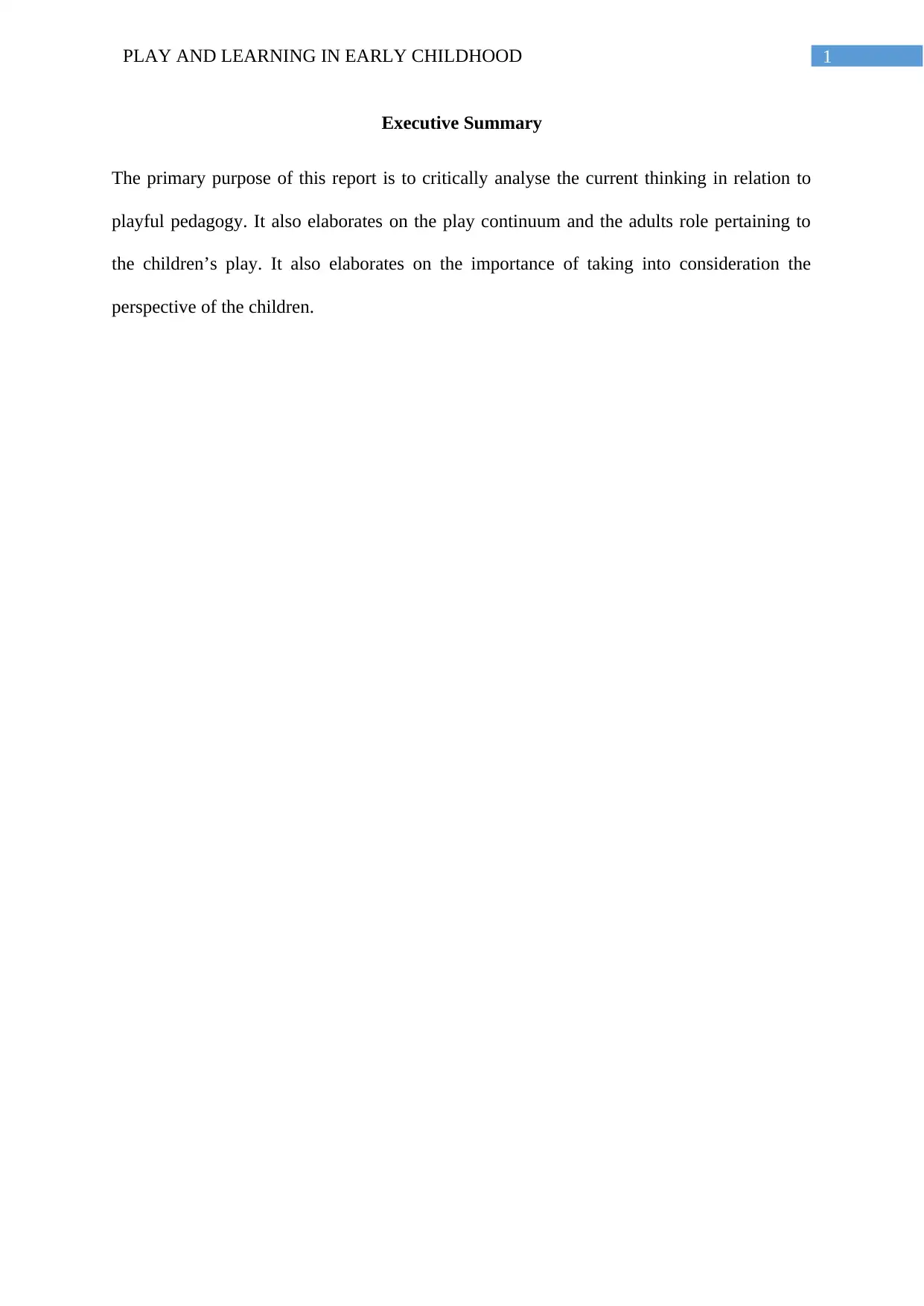
1PLAY AND LEARNING IN EARLY CHILDHOOD
Executive Summary
The primary purpose of this report is to critically analyse the current thinking in relation to
playful pedagogy. It also elaborates on the play continuum and the adults role pertaining to
the children’s play. It also elaborates on the importance of taking into consideration the
perspective of the children.
Executive Summary
The primary purpose of this report is to critically analyse the current thinking in relation to
playful pedagogy. It also elaborates on the play continuum and the adults role pertaining to
the children’s play. It also elaborates on the importance of taking into consideration the
perspective of the children.

2PLAY AND LEARNING IN EARLY CHILDHOOD
Table of Contents
Introduction................................................................................................................................3
Current thinking about meaning of play and playful pedagogy.................................................3
Play Continuum and adult role in children’s play......................................................................5
Importance of understanding the perspective of the children....................................................7
Conclusion..................................................................................................................................8
Personal Reflection....................................................................................................................9
References:...............................................................................................................................10
Table of Contents
Introduction................................................................................................................................3
Current thinking about meaning of play and playful pedagogy.................................................3
Play Continuum and adult role in children’s play......................................................................5
Importance of understanding the perspective of the children....................................................7
Conclusion..................................................................................................................................8
Personal Reflection....................................................................................................................9
References:...............................................................................................................................10
⊘ This is a preview!⊘
Do you want full access?
Subscribe today to unlock all pages.

Trusted by 1+ million students worldwide

3PLAY AND LEARNING IN EARLY CHILDHOOD
Introduction
Play helps in providing opportunities to the children of learning and it can help them
in discovering and creating. In the event of the children playing with the other children they
can create social groups that enable them in challenging the thought of others. Playing can
help the children in building new understanding (Casey 2010). This report discusses about the
meaning of play along with playful pedagogy. It also throws light on play continuum and the
role of the adult in that of children’s play. It also elaborates on the significance of taking the
perspective of the children and its importance in playful learning.
Current thinking about meaning of play and playful pedagogy
The learning environment can help in enriching the lives along with identities of the
children. The environment that can help in supporting learning should be vibrant that will be
responsive to the abilities of the children. The learning environment should be flexible that
can help in catering to the learning capacities of the children and it can help the children in
contributing ideas. Play can help in providing the children with the supportive environment in
which the children can ask questions and solve the problems (Perry, Dockett and Harley
2012, pp 154). Playful pedagogy can expand the thinking of the children and it can enhance
their desire of knowing. Playful pedagogy can lead to the promotion of positive disposition
towards that of learning (Robinson et al. 2018). Play based pedagogies can help the teacher in
interacting in a playful manner with the children that can play a pivotal role in shaping the
curriculum outcome without making use of the formal approaches. The playful pedagogy can
help in the co-construction of play between the educator and the children. The play-based
pedagogy prove to be creative and they prove to be innovative in relation to both teaching
along with learning (Ebbeck and Waniganayake 2016).The childhood educators can adopt
various roles and use strategies that can help in supporting children. Playful pedagogy helps
Introduction
Play helps in providing opportunities to the children of learning and it can help them
in discovering and creating. In the event of the children playing with the other children they
can create social groups that enable them in challenging the thought of others. Playing can
help the children in building new understanding (Casey 2010). This report discusses about the
meaning of play along with playful pedagogy. It also throws light on play continuum and the
role of the adult in that of children’s play. It also elaborates on the significance of taking the
perspective of the children and its importance in playful learning.
Current thinking about meaning of play and playful pedagogy
The learning environment can help in enriching the lives along with identities of the
children. The environment that can help in supporting learning should be vibrant that will be
responsive to the abilities of the children. The learning environment should be flexible that
can help in catering to the learning capacities of the children and it can help the children in
contributing ideas. Play can help in providing the children with the supportive environment in
which the children can ask questions and solve the problems (Perry, Dockett and Harley
2012, pp 154). Playful pedagogy can expand the thinking of the children and it can enhance
their desire of knowing. Playful pedagogy can lead to the promotion of positive disposition
towards that of learning (Robinson et al. 2018). Play based pedagogies can help the teacher in
interacting in a playful manner with the children that can play a pivotal role in shaping the
curriculum outcome without making use of the formal approaches. The playful pedagogy can
help in the co-construction of play between the educator and the children. The play-based
pedagogy prove to be creative and they prove to be innovative in relation to both teaching
along with learning (Ebbeck and Waniganayake 2016).The childhood educators can adopt
various roles and use strategies that can help in supporting children. Playful pedagogy helps
Paraphrase This Document
Need a fresh take? Get an instant paraphrase of this document with our AI Paraphraser

4PLAY AND LEARNING IN EARLY CHILDHOOD
the children in engaging in sustained shared conversation that can help in extending the
thinking process of children.
Learning in motion can help the teachers along with their families in grasping the idea
that the process of learning is dynamic. In the event of the children constructing the play
situations they do not want to master knowledge along with skills. The learning outcome can
be mediated with the aid of the play process. It has been found that when the children play
they cross the subject matter boundaries that is created by the adults. This can specially prove
to be useful for the children with language development problem as they can learn in an
effective meaning while playing that the traditional classroom cannot provide them. Playing
can help them in conveying their feelings and emotions and they will feel more comfortable
of communicating within a group van (Oers 2017). The playful activities can help the
children in building the disciplinary knowledge along with critical thinking skills (Ebbeck
and Waniganayake 2016).They can help the children in exploring and making connections
(Casey 2010). In playful learning, children can try out new ideas and test the different
theories. It can help the children in exploring the social relations and enable them to take
risks. According to Vygotsky, greatest achievements of the child can be achieved with the
help of play. The mode of playful learning can help the children in relaxing and challenging-
the state of mind that can prove to be conducive for learning (Robinson et al. 2018).
Play can be defined as a mental leisure activity that is undertaken for the purpose of
enjoyment and it does not have other alternative. Play can considered to be those activities
that can help an individual in reaping behavioural, social along with the psychological
rewards. The Planning for Play framework lays stress on the thinking ability of the student at
the time of play so that they can make the differentiation between things. In this kind of play,
the teachers discuss one aspect of a thing and then relate it to the other things that can enable
the children in learning while playing (Drake 2013). The play phase lays emphasis on the
the children in engaging in sustained shared conversation that can help in extending the
thinking process of children.
Learning in motion can help the teachers along with their families in grasping the idea
that the process of learning is dynamic. In the event of the children constructing the play
situations they do not want to master knowledge along with skills. The learning outcome can
be mediated with the aid of the play process. It has been found that when the children play
they cross the subject matter boundaries that is created by the adults. This can specially prove
to be useful for the children with language development problem as they can learn in an
effective meaning while playing that the traditional classroom cannot provide them. Playing
can help them in conveying their feelings and emotions and they will feel more comfortable
of communicating within a group van (Oers 2017). The playful activities can help the
children in building the disciplinary knowledge along with critical thinking skills (Ebbeck
and Waniganayake 2016).They can help the children in exploring and making connections
(Casey 2010). In playful learning, children can try out new ideas and test the different
theories. It can help the children in exploring the social relations and enable them to take
risks. According to Vygotsky, greatest achievements of the child can be achieved with the
help of play. The mode of playful learning can help the children in relaxing and challenging-
the state of mind that can prove to be conducive for learning (Robinson et al. 2018).
Play can be defined as a mental leisure activity that is undertaken for the purpose of
enjoyment and it does not have other alternative. Play can considered to be those activities
that can help an individual in reaping behavioural, social along with the psychological
rewards. The Planning for Play framework lays stress on the thinking ability of the student at
the time of play so that they can make the differentiation between things. In this kind of play,
the teachers discuss one aspect of a thing and then relate it to the other things that can enable
the children in learning while playing (Drake 2013). The play phase lays emphasis on the
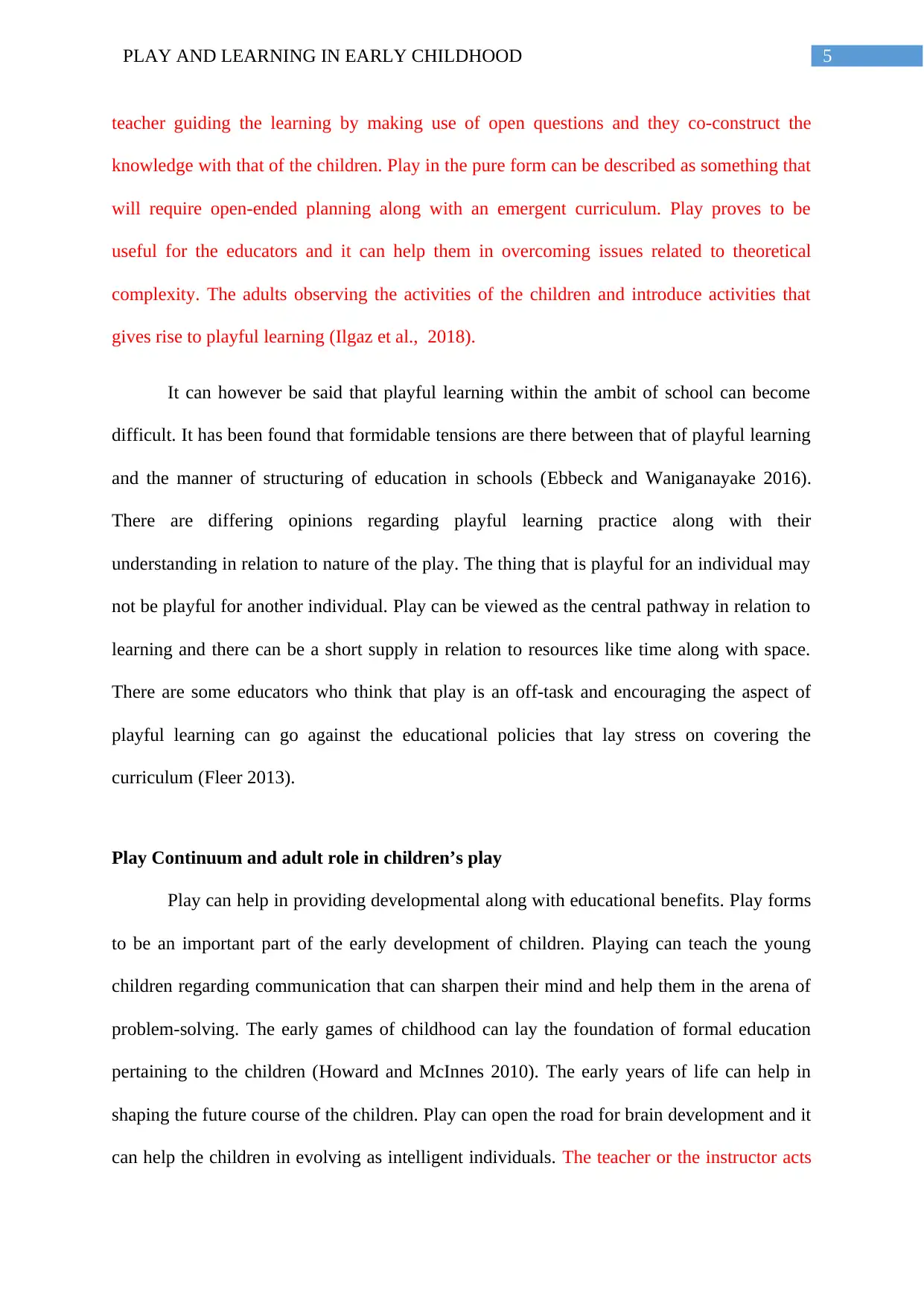
5PLAY AND LEARNING IN EARLY CHILDHOOD
teacher guiding the learning by making use of open questions and they co-construct the
knowledge with that of the children. Play in the pure form can be described as something that
will require open-ended planning along with an emergent curriculum. Play proves to be
useful for the educators and it can help them in overcoming issues related to theoretical
complexity. The adults observing the activities of the children and introduce activities that
gives rise to playful learning (Ilgaz et al., 2018).
It can however be said that playful learning within the ambit of school can become
difficult. It has been found that formidable tensions are there between that of playful learning
and the manner of structuring of education in schools (Ebbeck and Waniganayake 2016).
There are differing opinions regarding playful learning practice along with their
understanding in relation to nature of the play. The thing that is playful for an individual may
not be playful for another individual. Play can be viewed as the central pathway in relation to
learning and there can be a short supply in relation to resources like time along with space.
There are some educators who think that play is an off-task and encouraging the aspect of
playful learning can go against the educational policies that lay stress on covering the
curriculum (Fleer 2013).
Play Continuum and adult role in children’s play
Play can help in providing developmental along with educational benefits. Play forms
to be an important part of the early development of children. Playing can teach the young
children regarding communication that can sharpen their mind and help them in the arena of
problem-solving. The early games of childhood can lay the foundation of formal education
pertaining to the children (Howard and McInnes 2010). The early years of life can help in
shaping the future course of the children. Play can open the road for brain development and it
can help the children in evolving as intelligent individuals. The teacher or the instructor acts
teacher guiding the learning by making use of open questions and they co-construct the
knowledge with that of the children. Play in the pure form can be described as something that
will require open-ended planning along with an emergent curriculum. Play proves to be
useful for the educators and it can help them in overcoming issues related to theoretical
complexity. The adults observing the activities of the children and introduce activities that
gives rise to playful learning (Ilgaz et al., 2018).
It can however be said that playful learning within the ambit of school can become
difficult. It has been found that formidable tensions are there between that of playful learning
and the manner of structuring of education in schools (Ebbeck and Waniganayake 2016).
There are differing opinions regarding playful learning practice along with their
understanding in relation to nature of the play. The thing that is playful for an individual may
not be playful for another individual. Play can be viewed as the central pathway in relation to
learning and there can be a short supply in relation to resources like time along with space.
There are some educators who think that play is an off-task and encouraging the aspect of
playful learning can go against the educational policies that lay stress on covering the
curriculum (Fleer 2013).
Play Continuum and adult role in children’s play
Play can help in providing developmental along with educational benefits. Play forms
to be an important part of the early development of children. Playing can teach the young
children regarding communication that can sharpen their mind and help them in the arena of
problem-solving. The early games of childhood can lay the foundation of formal education
pertaining to the children (Howard and McInnes 2010). The early years of life can help in
shaping the future course of the children. Play can open the road for brain development and it
can help the children in evolving as intelligent individuals. The teacher or the instructor acts
⊘ This is a preview!⊘
Do you want full access?
Subscribe today to unlock all pages.

Trusted by 1+ million students worldwide
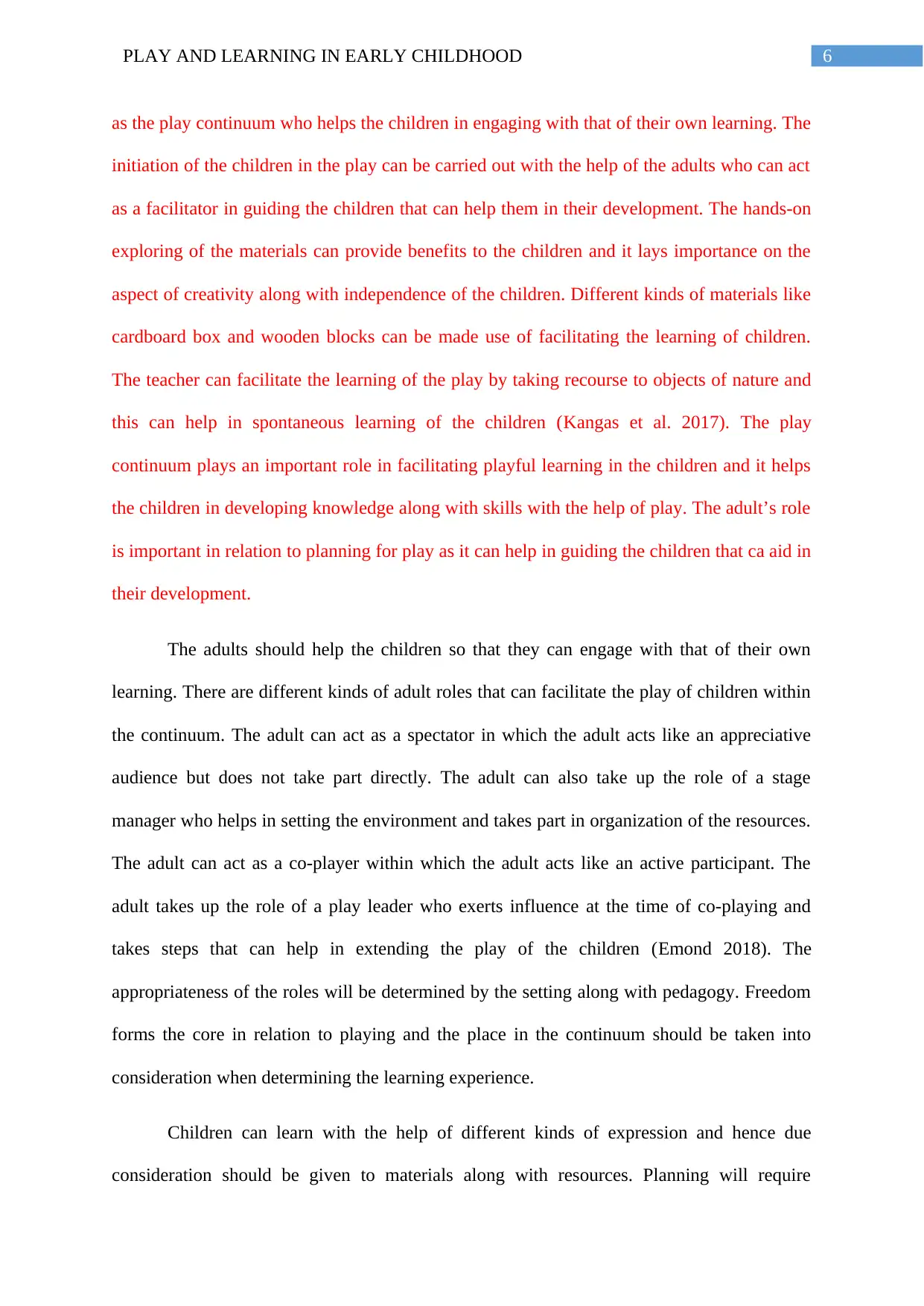
6PLAY AND LEARNING IN EARLY CHILDHOOD
as the play continuum who helps the children in engaging with that of their own learning. The
initiation of the children in the play can be carried out with the help of the adults who can act
as a facilitator in guiding the children that can help them in their development. The hands-on
exploring of the materials can provide benefits to the children and it lays importance on the
aspect of creativity along with independence of the children. Different kinds of materials like
cardboard box and wooden blocks can be made use of facilitating the learning of children.
The teacher can facilitate the learning of the play by taking recourse to objects of nature and
this can help in spontaneous learning of the children (Kangas et al. 2017). The play
continuum plays an important role in facilitating playful learning in the children and it helps
the children in developing knowledge along with skills with the help of play. The adult’s role
is important in relation to planning for play as it can help in guiding the children that ca aid in
their development.
The adults should help the children so that they can engage with that of their own
learning. There are different kinds of adult roles that can facilitate the play of children within
the continuum. The adult can act as a spectator in which the adult acts like an appreciative
audience but does not take part directly. The adult can also take up the role of a stage
manager who helps in setting the environment and takes part in organization of the resources.
The adult can act as a co-player within which the adult acts like an active participant. The
adult takes up the role of a play leader who exerts influence at the time of co-playing and
takes steps that can help in extending the play of the children (Emond 2018). The
appropriateness of the roles will be determined by the setting along with pedagogy. Freedom
forms the core in relation to playing and the place in the continuum should be taken into
consideration when determining the learning experience.
Children can learn with the help of different kinds of expression and hence due
consideration should be given to materials along with resources. Planning will require
as the play continuum who helps the children in engaging with that of their own learning. The
initiation of the children in the play can be carried out with the help of the adults who can act
as a facilitator in guiding the children that can help them in their development. The hands-on
exploring of the materials can provide benefits to the children and it lays importance on the
aspect of creativity along with independence of the children. Different kinds of materials like
cardboard box and wooden blocks can be made use of facilitating the learning of children.
The teacher can facilitate the learning of the play by taking recourse to objects of nature and
this can help in spontaneous learning of the children (Kangas et al. 2017). The play
continuum plays an important role in facilitating playful learning in the children and it helps
the children in developing knowledge along with skills with the help of play. The adult’s role
is important in relation to planning for play as it can help in guiding the children that ca aid in
their development.
The adults should help the children so that they can engage with that of their own
learning. There are different kinds of adult roles that can facilitate the play of children within
the continuum. The adult can act as a spectator in which the adult acts like an appreciative
audience but does not take part directly. The adult can also take up the role of a stage
manager who helps in setting the environment and takes part in organization of the resources.
The adult can act as a co-player within which the adult acts like an active participant. The
adult takes up the role of a play leader who exerts influence at the time of co-playing and
takes steps that can help in extending the play of the children (Emond 2018). The
appropriateness of the roles will be determined by the setting along with pedagogy. Freedom
forms the core in relation to playing and the place in the continuum should be taken into
consideration when determining the learning experience.
Children can learn with the help of different kinds of expression and hence due
consideration should be given to materials along with resources. Planning will require
Paraphrase This Document
Need a fresh take? Get an instant paraphrase of this document with our AI Paraphraser
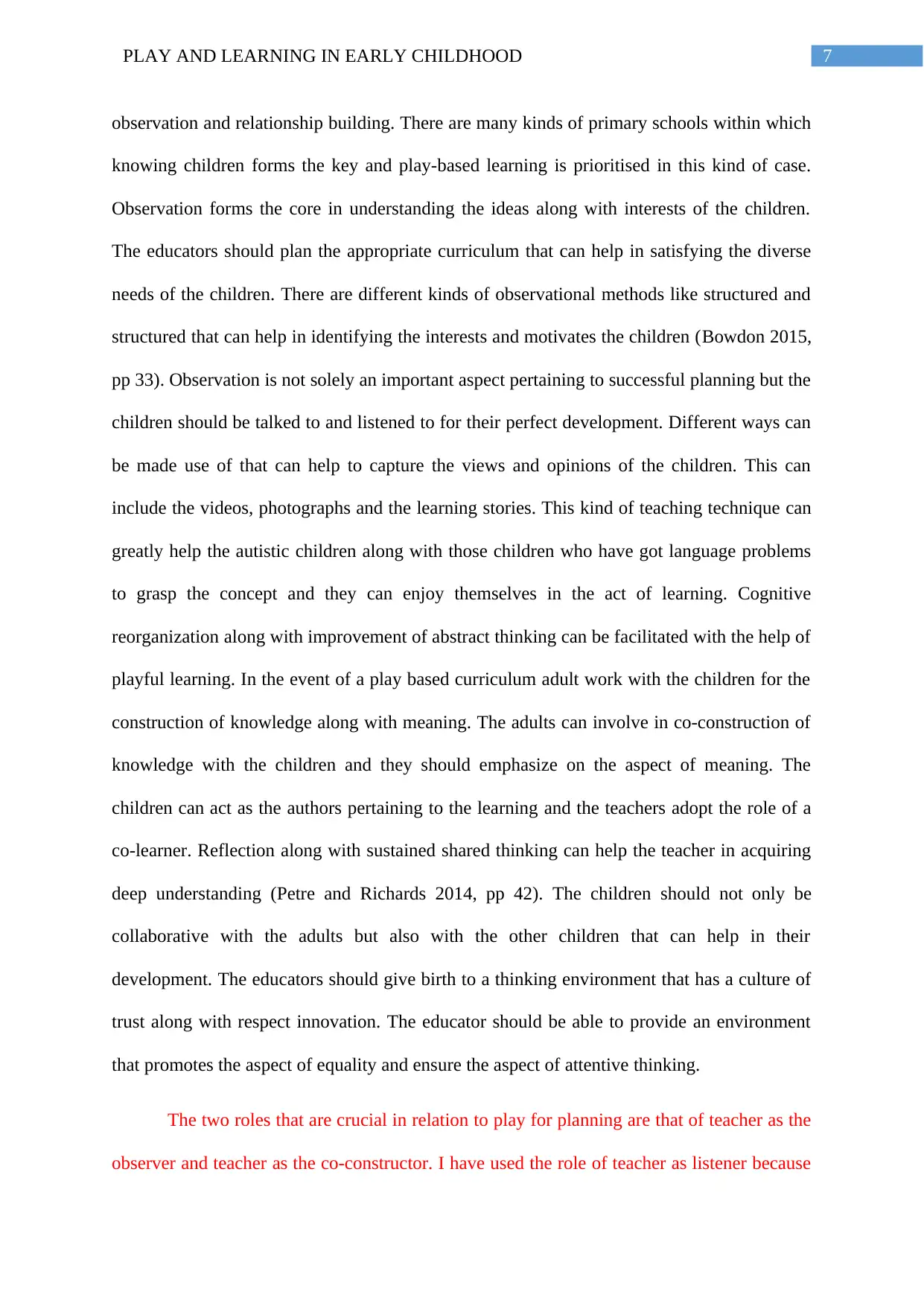
7PLAY AND LEARNING IN EARLY CHILDHOOD
observation and relationship building. There are many kinds of primary schools within which
knowing children forms the key and play-based learning is prioritised in this kind of case.
Observation forms the core in understanding the ideas along with interests of the children.
The educators should plan the appropriate curriculum that can help in satisfying the diverse
needs of the children. There are different kinds of observational methods like structured and
structured that can help in identifying the interests and motivates the children (Bowdon 2015,
pp 33). Observation is not solely an important aspect pertaining to successful planning but the
children should be talked to and listened to for their perfect development. Different ways can
be made use of that can help to capture the views and opinions of the children. This can
include the videos, photographs and the learning stories. This kind of teaching technique can
greatly help the autistic children along with those children who have got language problems
to grasp the concept and they can enjoy themselves in the act of learning. Cognitive
reorganization along with improvement of abstract thinking can be facilitated with the help of
playful learning. In the event of a play based curriculum adult work with the children for the
construction of knowledge along with meaning. The adults can involve in co-construction of
knowledge with the children and they should emphasize on the aspect of meaning. The
children can act as the authors pertaining to the learning and the teachers adopt the role of a
co-learner. Reflection along with sustained shared thinking can help the teacher in acquiring
deep understanding (Petre and Richards 2014, pp 42). The children should not only be
collaborative with the adults but also with the other children that can help in their
development. The educators should give birth to a thinking environment that has a culture of
trust along with respect innovation. The educator should be able to provide an environment
that promotes the aspect of equality and ensure the aspect of attentive thinking.
The two roles that are crucial in relation to play for planning are that of teacher as the
observer and teacher as the co-constructor. I have used the role of teacher as listener because
observation and relationship building. There are many kinds of primary schools within which
knowing children forms the key and play-based learning is prioritised in this kind of case.
Observation forms the core in understanding the ideas along with interests of the children.
The educators should plan the appropriate curriculum that can help in satisfying the diverse
needs of the children. There are different kinds of observational methods like structured and
structured that can help in identifying the interests and motivates the children (Bowdon 2015,
pp 33). Observation is not solely an important aspect pertaining to successful planning but the
children should be talked to and listened to for their perfect development. Different ways can
be made use of that can help to capture the views and opinions of the children. This can
include the videos, photographs and the learning stories. This kind of teaching technique can
greatly help the autistic children along with those children who have got language problems
to grasp the concept and they can enjoy themselves in the act of learning. Cognitive
reorganization along with improvement of abstract thinking can be facilitated with the help of
playful learning. In the event of a play based curriculum adult work with the children for the
construction of knowledge along with meaning. The adults can involve in co-construction of
knowledge with the children and they should emphasize on the aspect of meaning. The
children can act as the authors pertaining to the learning and the teachers adopt the role of a
co-learner. Reflection along with sustained shared thinking can help the teacher in acquiring
deep understanding (Petre and Richards 2014, pp 42). The children should not only be
collaborative with the adults but also with the other children that can help in their
development. The educators should give birth to a thinking environment that has a culture of
trust along with respect innovation. The educator should be able to provide an environment
that promotes the aspect of equality and ensure the aspect of attentive thinking.
The two roles that are crucial in relation to play for planning are that of teacher as the
observer and teacher as the co-constructor. I have used the role of teacher as listener because
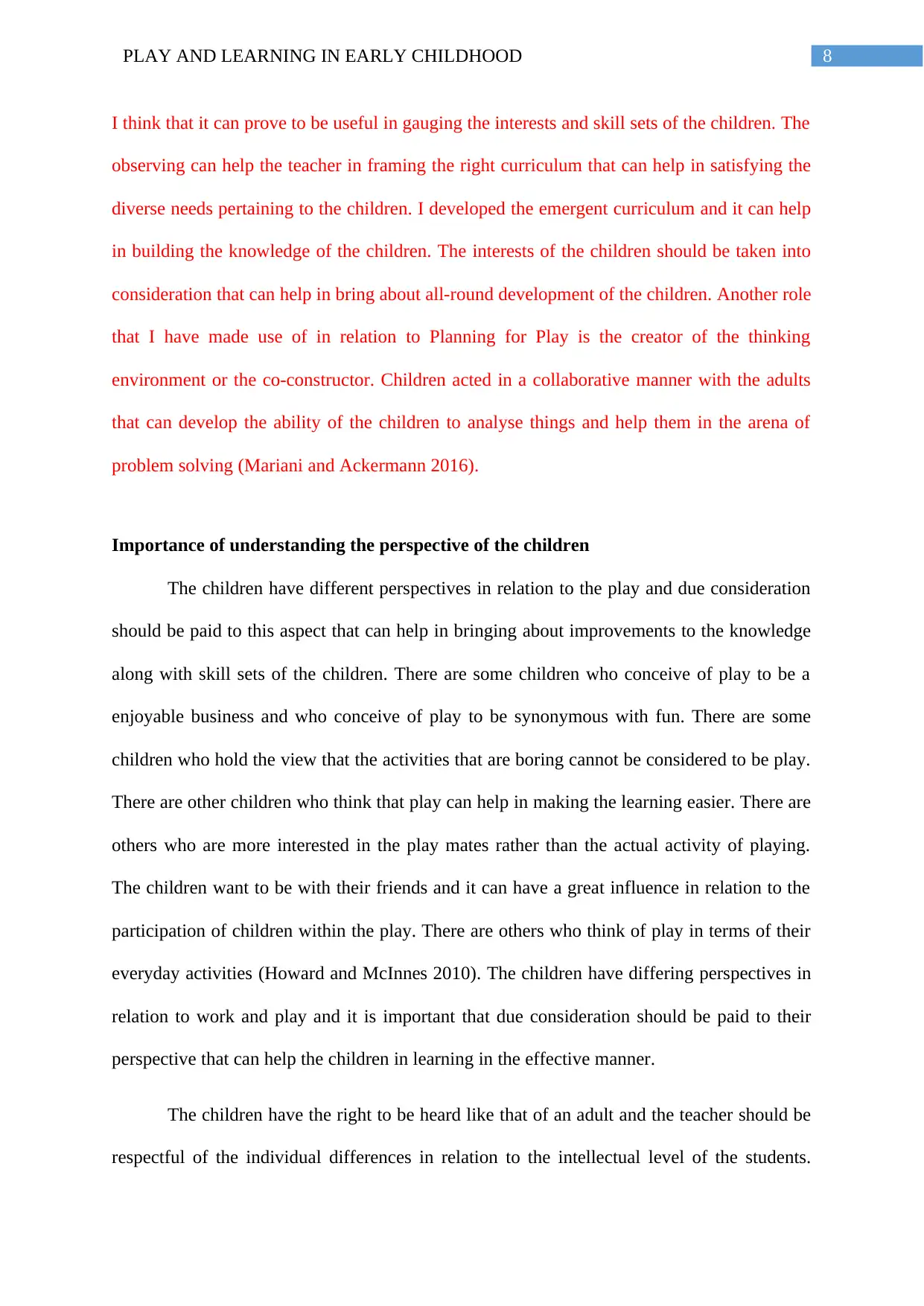
8PLAY AND LEARNING IN EARLY CHILDHOOD
I think that it can prove to be useful in gauging the interests and skill sets of the children. The
observing can help the teacher in framing the right curriculum that can help in satisfying the
diverse needs pertaining to the children. I developed the emergent curriculum and it can help
in building the knowledge of the children. The interests of the children should be taken into
consideration that can help in bring about all-round development of the children. Another role
that I have made use of in relation to Planning for Play is the creator of the thinking
environment or the co-constructor. Children acted in a collaborative manner with the adults
that can develop the ability of the children to analyse things and help them in the arena of
problem solving (Mariani and Ackermann 2016).
Importance of understanding the perspective of the children
The children have different perspectives in relation to the play and due consideration
should be paid to this aspect that can help in bringing about improvements to the knowledge
along with skill sets of the children. There are some children who conceive of play to be a
enjoyable business and who conceive of play to be synonymous with fun. There are some
children who hold the view that the activities that are boring cannot be considered to be play.
There are other children who think that play can help in making the learning easier. There are
others who are more interested in the play mates rather than the actual activity of playing.
The children want to be with their friends and it can have a great influence in relation to the
participation of children within the play. There are others who think of play in terms of their
everyday activities (Howard and McInnes 2010). The children have differing perspectives in
relation to work and play and it is important that due consideration should be paid to their
perspective that can help the children in learning in the effective manner.
The children have the right to be heard like that of an adult and the teacher should be
respectful of the individual differences in relation to the intellectual level of the students.
I think that it can prove to be useful in gauging the interests and skill sets of the children. The
observing can help the teacher in framing the right curriculum that can help in satisfying the
diverse needs pertaining to the children. I developed the emergent curriculum and it can help
in building the knowledge of the children. The interests of the children should be taken into
consideration that can help in bring about all-round development of the children. Another role
that I have made use of in relation to Planning for Play is the creator of the thinking
environment or the co-constructor. Children acted in a collaborative manner with the adults
that can develop the ability of the children to analyse things and help them in the arena of
problem solving (Mariani and Ackermann 2016).
Importance of understanding the perspective of the children
The children have different perspectives in relation to the play and due consideration
should be paid to this aspect that can help in bringing about improvements to the knowledge
along with skill sets of the children. There are some children who conceive of play to be a
enjoyable business and who conceive of play to be synonymous with fun. There are some
children who hold the view that the activities that are boring cannot be considered to be play.
There are other children who think that play can help in making the learning easier. There are
others who are more interested in the play mates rather than the actual activity of playing.
The children want to be with their friends and it can have a great influence in relation to the
participation of children within the play. There are others who think of play in terms of their
everyday activities (Howard and McInnes 2010). The children have differing perspectives in
relation to work and play and it is important that due consideration should be paid to their
perspective that can help the children in learning in the effective manner.
The children have the right to be heard like that of an adult and the teacher should be
respectful of the individual differences in relation to the intellectual level of the students.
⊘ This is a preview!⊘
Do you want full access?
Subscribe today to unlock all pages.

Trusted by 1+ million students worldwide

9PLAY AND LEARNING IN EARLY CHILDHOOD
There are students with disabilities like the autistic students and the teacher should be
respectful to these students. There are others who have language development issue and the
curriculum should be framed after taking into consideration their individual requirements and
need (Fleer 2013). The teacher should interact with the students so that he can know about
their knowledge and capabilities and deliver knowledge on the basis of their abilities. The
teachers act as carrier of various kinds of ideas regarding what would account to be a “good
perspective” on that of children. The experiences along with manner of expression of the
children should be listened to for the development of the children in early childhood. It is
important to create conditions for authentically gaining the voice of the children as it will
enable the children to realize their full potential and the planning of the curriculum will be on
the basis of the learning needs pertaining to the children. The development of the emergent
curriculum that helps in building what the children already know on the basis of their
interests (Petre and Richards 2014). The conditions should be created for gaining the voice of
the children as it can help in making the thinking of the children visible that can aid in the
process of collaborative learning in playful pedagogy. It is important for getting perspective
of the children because the interests of the children can vary and it is necessary to understand
that the playful activity is amusing for the children that can keep them engaged and help them
in their development.
Conclusion
Play can provide various opportunities to the children that can help them in the act of
creation. Play can provide children with supportive environment that can help the children in
solving problems and asking questions. Playful pedagogy can play an important role in
broadening the process of thinking of the children and it augments their knowledge. Playing
can help the children in providing lessons in relation to communication and it can provide a
There are students with disabilities like the autistic students and the teacher should be
respectful to these students. There are others who have language development issue and the
curriculum should be framed after taking into consideration their individual requirements and
need (Fleer 2013). The teacher should interact with the students so that he can know about
their knowledge and capabilities and deliver knowledge on the basis of their abilities. The
teachers act as carrier of various kinds of ideas regarding what would account to be a “good
perspective” on that of children. The experiences along with manner of expression of the
children should be listened to for the development of the children in early childhood. It is
important to create conditions for authentically gaining the voice of the children as it will
enable the children to realize their full potential and the planning of the curriculum will be on
the basis of the learning needs pertaining to the children. The development of the emergent
curriculum that helps in building what the children already know on the basis of their
interests (Petre and Richards 2014). The conditions should be created for gaining the voice of
the children as it can help in making the thinking of the children visible that can aid in the
process of collaborative learning in playful pedagogy. It is important for getting perspective
of the children because the interests of the children can vary and it is necessary to understand
that the playful activity is amusing for the children that can keep them engaged and help them
in their development.
Conclusion
Play can provide various opportunities to the children that can help them in the act of
creation. Play can provide children with supportive environment that can help the children in
solving problems and asking questions. Playful pedagogy can play an important role in
broadening the process of thinking of the children and it augments their knowledge. Playing
can help the children in providing lessons in relation to communication and it can provide a
Paraphrase This Document
Need a fresh take? Get an instant paraphrase of this document with our AI Paraphraser
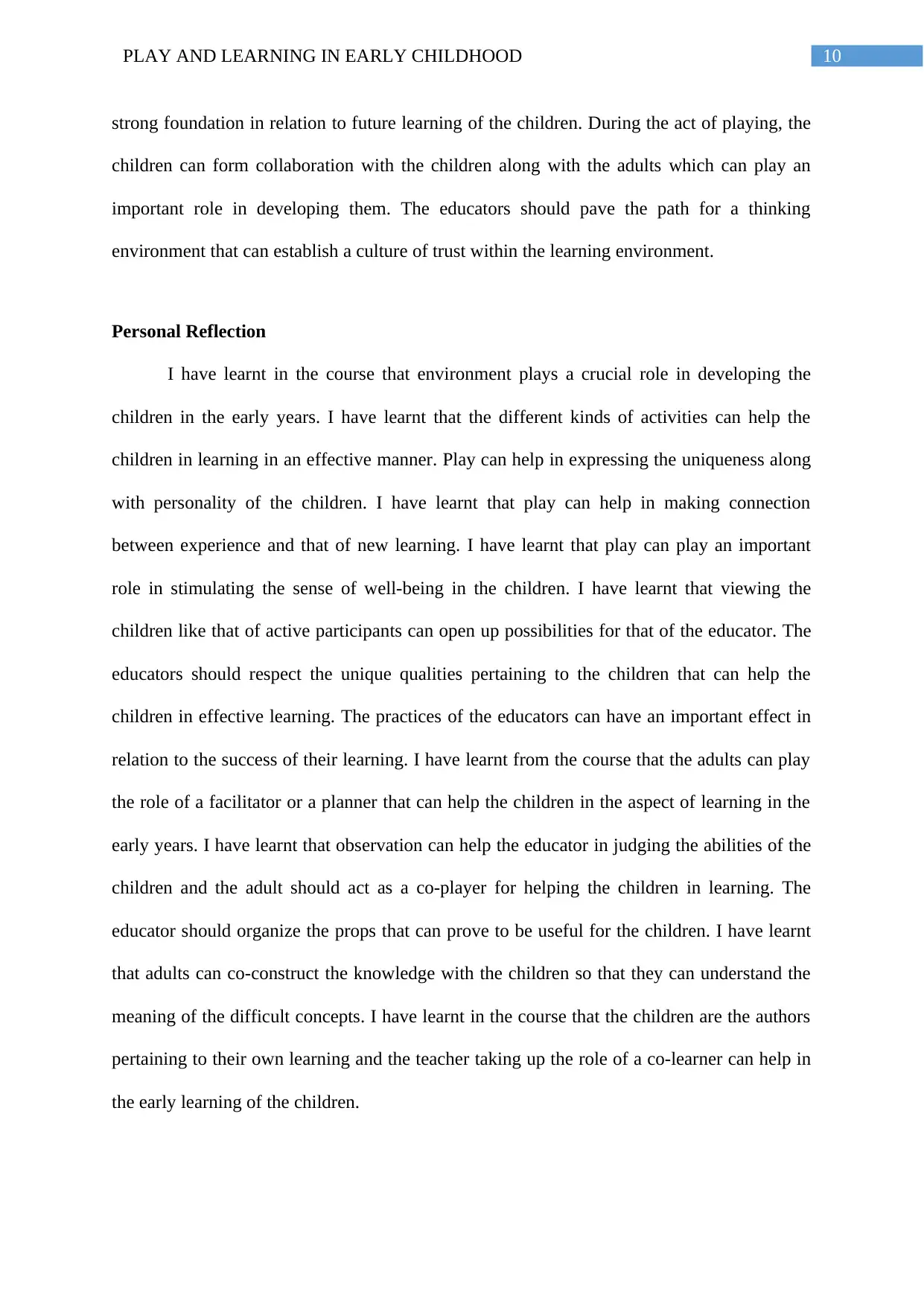
10PLAY AND LEARNING IN EARLY CHILDHOOD
strong foundation in relation to future learning of the children. During the act of playing, the
children can form collaboration with the children along with the adults which can play an
important role in developing them. The educators should pave the path for a thinking
environment that can establish a culture of trust within the learning environment.
Personal Reflection
I have learnt in the course that environment plays a crucial role in developing the
children in the early years. I have learnt that the different kinds of activities can help the
children in learning in an effective manner. Play can help in expressing the uniqueness along
with personality of the children. I have learnt that play can help in making connection
between experience and that of new learning. I have learnt that play can play an important
role in stimulating the sense of well-being in the children. I have learnt that viewing the
children like that of active participants can open up possibilities for that of the educator. The
educators should respect the unique qualities pertaining to the children that can help the
children in effective learning. The practices of the educators can have an important effect in
relation to the success of their learning. I have learnt from the course that the adults can play
the role of a facilitator or a planner that can help the children in the aspect of learning in the
early years. I have learnt that observation can help the educator in judging the abilities of the
children and the adult should act as a co-player for helping the children in learning. The
educator should organize the props that can prove to be useful for the children. I have learnt
that adults can co-construct the knowledge with the children so that they can understand the
meaning of the difficult concepts. I have learnt in the course that the children are the authors
pertaining to their own learning and the teacher taking up the role of a co-learner can help in
the early learning of the children.
strong foundation in relation to future learning of the children. During the act of playing, the
children can form collaboration with the children along with the adults which can play an
important role in developing them. The educators should pave the path for a thinking
environment that can establish a culture of trust within the learning environment.
Personal Reflection
I have learnt in the course that environment plays a crucial role in developing the
children in the early years. I have learnt that the different kinds of activities can help the
children in learning in an effective manner. Play can help in expressing the uniqueness along
with personality of the children. I have learnt that play can help in making connection
between experience and that of new learning. I have learnt that play can play an important
role in stimulating the sense of well-being in the children. I have learnt that viewing the
children like that of active participants can open up possibilities for that of the educator. The
educators should respect the unique qualities pertaining to the children that can help the
children in effective learning. The practices of the educators can have an important effect in
relation to the success of their learning. I have learnt from the course that the adults can play
the role of a facilitator or a planner that can help the children in the aspect of learning in the
early years. I have learnt that observation can help the educator in judging the abilities of the
children and the adult should act as a co-player for helping the children in learning. The
educator should organize the props that can prove to be useful for the children. I have learnt
that adults can co-construct the knowledge with the children so that they can understand the
meaning of the difficult concepts. I have learnt in the course that the children are the authors
pertaining to their own learning and the teacher taking up the role of a co-learner can help in
the early learning of the children.
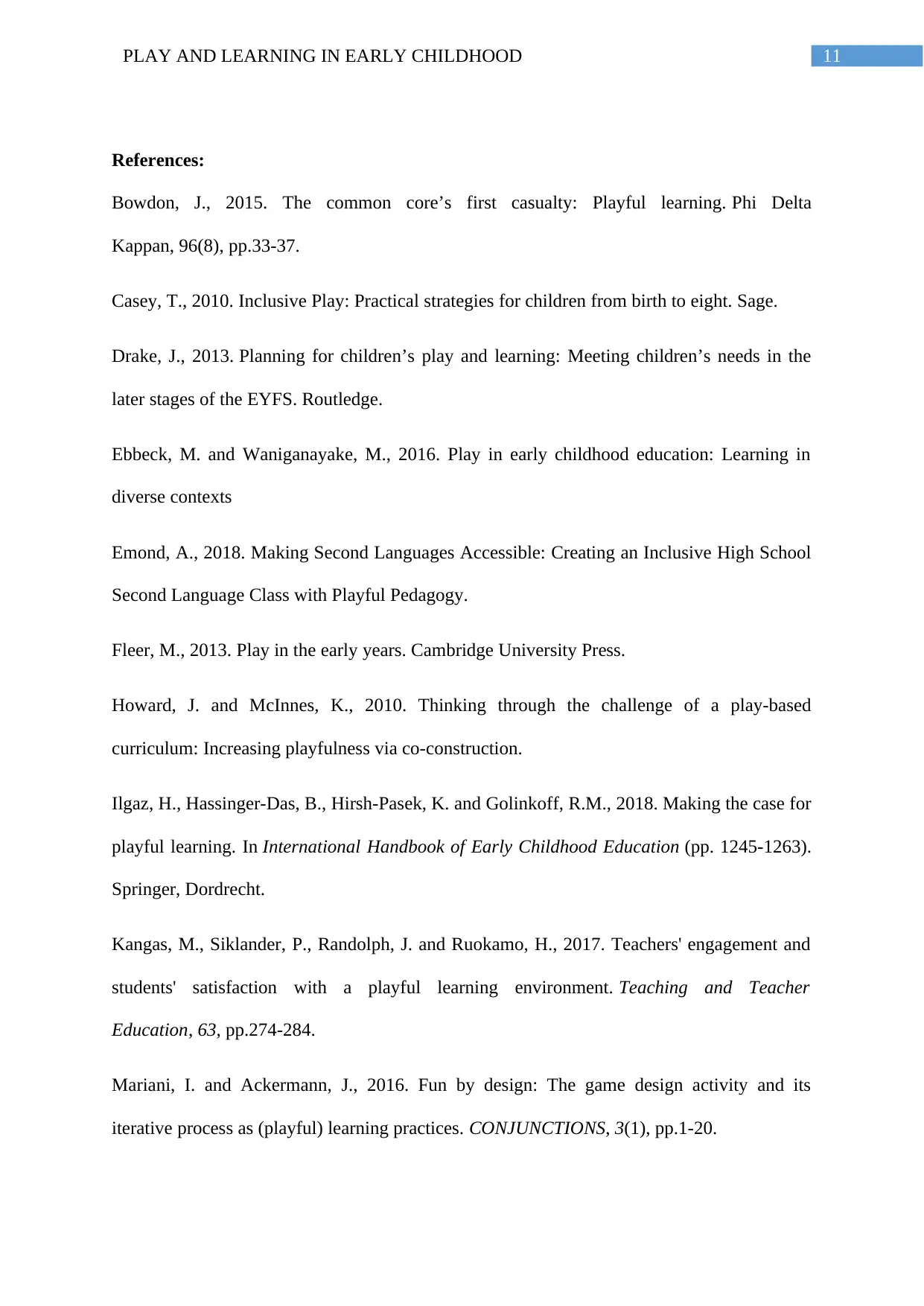
11PLAY AND LEARNING IN EARLY CHILDHOOD
References:
Bowdon, J., 2015. The common core’s first casualty: Playful learning. Phi Delta
Kappan, 96(8), pp.33-37.
Casey, T., 2010. Inclusive Play: Practical strategies for children from birth to eight. Sage.
Drake, J., 2013. Planning for children’s play and learning: Meeting children’s needs in the
later stages of the EYFS. Routledge.
Ebbeck, M. and Waniganayake, M., 2016. Play in early childhood education: Learning in
diverse contexts
Emond, A., 2018. Making Second Languages Accessible: Creating an Inclusive High School
Second Language Class with Playful Pedagogy.
Fleer, M., 2013. Play in the early years. Cambridge University Press.
Howard, J. and McInnes, K., 2010. Thinking through the challenge of a play-based
curriculum: Increasing playfulness via co-construction.
Ilgaz, H., Hassinger-Das, B., Hirsh-Pasek, K. and Golinkoff, R.M., 2018. Making the case for
playful learning. In International Handbook of Early Childhood Education (pp. 1245-1263).
Springer, Dordrecht.
Kangas, M., Siklander, P., Randolph, J. and Ruokamo, H., 2017. Teachers' engagement and
students' satisfaction with a playful learning environment. Teaching and Teacher
Education, 63, pp.274-284.
Mariani, I. and Ackermann, J., 2016. Fun by design: The game design activity and its
iterative process as (playful) learning practices. CONJUNCTIONS, 3(1), pp.1-20.
References:
Bowdon, J., 2015. The common core’s first casualty: Playful learning. Phi Delta
Kappan, 96(8), pp.33-37.
Casey, T., 2010. Inclusive Play: Practical strategies for children from birth to eight. Sage.
Drake, J., 2013. Planning for children’s play and learning: Meeting children’s needs in the
later stages of the EYFS. Routledge.
Ebbeck, M. and Waniganayake, M., 2016. Play in early childhood education: Learning in
diverse contexts
Emond, A., 2018. Making Second Languages Accessible: Creating an Inclusive High School
Second Language Class with Playful Pedagogy.
Fleer, M., 2013. Play in the early years. Cambridge University Press.
Howard, J. and McInnes, K., 2010. Thinking through the challenge of a play-based
curriculum: Increasing playfulness via co-construction.
Ilgaz, H., Hassinger-Das, B., Hirsh-Pasek, K. and Golinkoff, R.M., 2018. Making the case for
playful learning. In International Handbook of Early Childhood Education (pp. 1245-1263).
Springer, Dordrecht.
Kangas, M., Siklander, P., Randolph, J. and Ruokamo, H., 2017. Teachers' engagement and
students' satisfaction with a playful learning environment. Teaching and Teacher
Education, 63, pp.274-284.
Mariani, I. and Ackermann, J., 2016. Fun by design: The game design activity and its
iterative process as (playful) learning practices. CONJUNCTIONS, 3(1), pp.1-20.
⊘ This is a preview!⊘
Do you want full access?
Subscribe today to unlock all pages.

Trusted by 1+ million students worldwide
1 out of 13
Related Documents
Your All-in-One AI-Powered Toolkit for Academic Success.
+13062052269
info@desklib.com
Available 24*7 on WhatsApp / Email
![[object Object]](/_next/static/media/star-bottom.7253800d.svg)
Unlock your academic potential
Copyright © 2020–2025 A2Z Services. All Rights Reserved. Developed and managed by ZUCOL.




